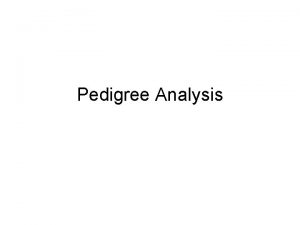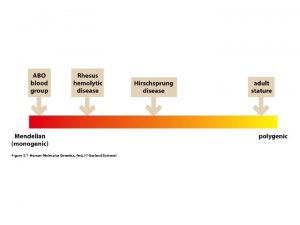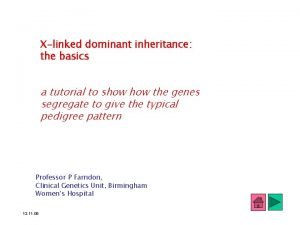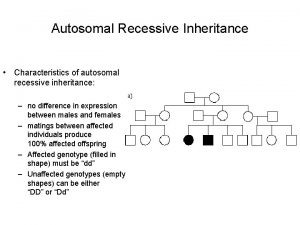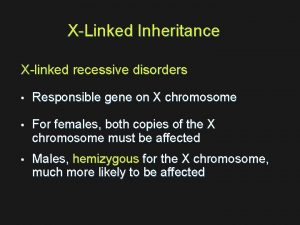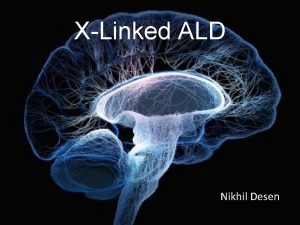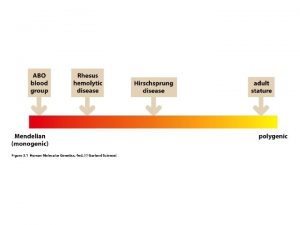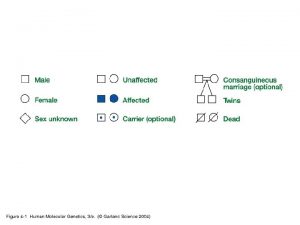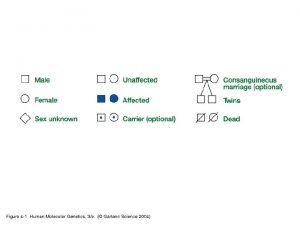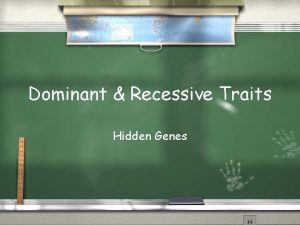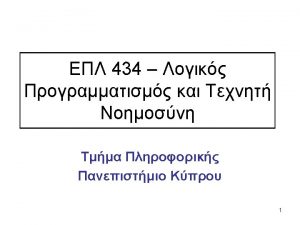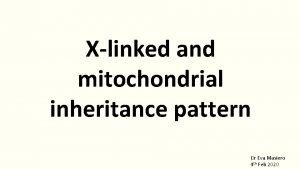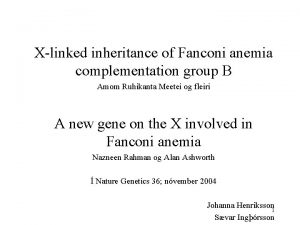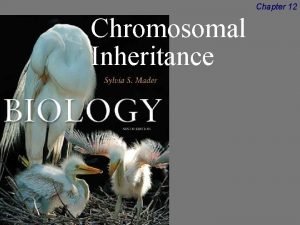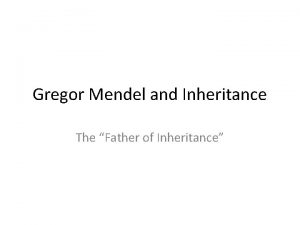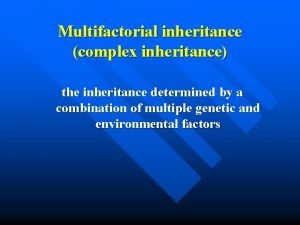Xlinked recessive inheritance where the father is affected




















- Slides: 20

X-linked recessive inheritance where the father is affected: the basics a tutorial to show the genes segregate to give the typical pedigree pattern Professor P Farndon, Clinical Genetics Unit, Birmingham Women’s Hospital 13. 11. 06

Question: How can one understand the risks of an Xlinked recessive condition where a father is affected? I: 1 III: 1 IV: 1 III: 2 IV: 2 II: 2 III: 3 III: 4

Question: How can one understand the risks of an Xlinked recessive condition where a father is affected? Answer: By imagining which of the sex chromosomes of the parents have been passed on to children as shown on the next few screens Gene Reminder: Hemizygotes (males) with one copy of the altered gene are affected X-Chromosome

Male karyotype Female karyotype Humans have 23 pairs of chromosomes: 22 pairs of autosomes and 1 pair of sex chromosomes

The male sex chromosomes: an X and a Y The female sex chromosomes: two X chromosomes

X-LINKED RECESSIVE INHERITANCE: father affected Parents Affected Father An affected male will have an X chromosome with a altered gene and a Y chromosome Mother A woman who is not a carrier of an Xlinked recessive disorder has two copies of the normal gene - one on each X chromosome

X-LINKED RECESSIVE INHERITANCE: father affected Parents Affected Father Mother Gametes X The father passes on either his X chromosome containing the altered gene Y or his Y chromosome (and so determines the sex of the fetus) X The mother passes on one X or the other of her X chromosomes (both with normal genes)

X-LINKED RECESSIVE INHERITANCE: father affected Parents Affected Father Mother Gametes X Y X There are four different combinations of the two chromosomes from each parent X

X-LINKED RECESSIVE INHERITANCE: father affected Parents Affected Father Mother Gametes X Y X Offspring This child has inherited the paternal X chromosome with the altered gene (and so is female) and the maternal X chromosome with the normal gene Daughter X

X-LINKED RECESSIVE INHERITANCE: father affected Parents Affected Father Mother Gametes X Y X X Offspring Daughter This child has inherited the paternal X chromosome with the altered gene (and so is female) and the other maternal X chromosome with a normal gene

X-LINKED RECESSIVE INHERITANCE: father affected Parents Affected Father Mother Gametes X Y X Offspring Daughter Son X

X-LINKED RECESSIVE INHERITANCE: father affected Parents Affected Father Mother Gametes X Y X Offspring This child has inherited the paternal Y chromosome (and so is male) and a maternal X chromosome with a normal gene Son X

X-LINKED RECESSIVE INHERITANCE: father affected Parents Affected Father Mother Gametes X Y X X Offspring Daughter Son

X-LINKED RECESSIVE INHERITANCE: father affected Parents Affected Father Mother Gametes X Y X X Offspring This child has inherited the paternal Y chromosome (and so is male) and the other maternal X chromosome with a normal gene Son

X-LINKED RECESSIVE INHERITANCE: father affected Parents Affected Father Mother Gametes X Offspring Daughter Y X X Which children are affected by the disease? Daughter Son

X-LINKED RECESSIVE INHERITANCE: father affected Parents Affected Father Mother Gametes X Unaffected carrier Daughter Y Unaffected carrier Daughter X X Unaffected male Son

X-LINKED RECESSIVE INHERITANCE: father affected All the children of a male with an X-linked recessive disorder are therefore unaffected by his X-linked disease. All his daughters will be carriers. Their sons will inherit either the X-chromosome with the normal gene or the Xchromosome with the altered gene.

Examples of X-linked recessive diseases UK frequency / 10, 000 males Fragile X syndrome 5 Non-specific X-linked mental retardation 5 Duchenne muscular dystrophy 3 Becker muscular dystrophy 0. 5 Haemophilia A (factor VIII) 2 Haemophilia B (factor IX) 0. 3

X-linked recessive conditions are part of the group of single gene disorders, which also include autosomal dominant and recessive disorders. They are important clinically because of the high risks to other family members. Gene X-Chromosome

The end! • Thank you for completing this revision aid • We are interested in your comments about this aid. Please email Professor Farndon. (p. a. farndon@bham. ac. uk) © P Farndon 2003
 X linked dominant pedigree
X linked dominant pedigree Xlinked pedigree
Xlinked pedigree X linked dominant examples
X linked dominant examples Xlinked traits
Xlinked traits Autosomal recessive
Autosomal recessive Sơ đồ cơ thể người
Sơ đồ cơ thể người Số.nguyên tố
Số.nguyên tố Tỉ lệ cơ thể trẻ em
Tỉ lệ cơ thể trẻ em Tia chieu sa te
Tia chieu sa te đặc điểm cơ thể của người tối cổ
đặc điểm cơ thể của người tối cổ Các châu lục và đại dương trên thế giới
Các châu lục và đại dương trên thế giới ưu thế lai là gì
ưu thế lai là gì Các môn thể thao bắt đầu bằng từ đua
Các môn thể thao bắt đầu bằng từ đua Tư thế ngồi viết
Tư thế ngồi viết Cái miệng bé xinh thế chỉ nói điều hay thôi
Cái miệng bé xinh thế chỉ nói điều hay thôi Hình ảnh bộ gõ cơ thể búng tay
Hình ảnh bộ gõ cơ thể búng tay Mật thư tọa độ 5x5
Mật thư tọa độ 5x5 Tư thế ngồi viết
Tư thế ngồi viết Thế nào là giọng cùng tên?
Thế nào là giọng cùng tên? Gấu đi như thế nào
Gấu đi như thế nào Thẻ vin
Thẻ vin
